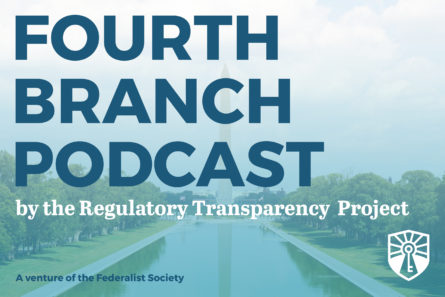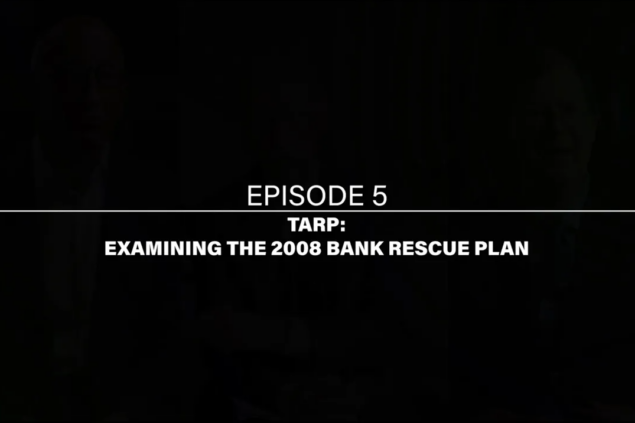Deep Dive Episode 59 – Cedar Point Nursery v. Shiroma

On May 8, 2019, the Ninth Circuit issued a 2-1 decision in Cedar Point Nursery v. Shiroma. In Cedar Point, California agricultural growers asked the court to invalidate an Agricultural Labor Relations Board regulation that allowed union organizers to come on to the growers’ property to solicit workers to join the union for 3 hours per day and 120 days per year. The growers contend that the regulation amounts to a physical taking under the Fifth Amendment. The Ninth Circuit majority rejected that argument, and held that the physical takings doctrine did not apply because the union organizers were not allowed around-the-clock access to the growers’ property.
In this podcast, hear reactions from Wen Fa and Bethany Berger.
Transcript
Although this transcript is largely accurate, in some cases it could be incomplete or inaccurate due to inaudible passages or transcription errors.
Operator: Welcome to Free Lunch, the podcast of The Federalist Society’s Regulatory Transparency Project. All expressions of opinion are those of the speakers.
On June 13th, RTP and The Federalist Society’s Environmental Law & Property Rights Practice Group sponsored a call to discuss the Ninth Circuit’s recently issued 2-1 decision in Cedar Point Nursery v. Shiroma. The case involves a challenge to the California Agricultural Labor Relations Board Regulation that allowed union organizers to come onto the grower’s property to solicit workers to join the union for three hours per day and 120 days per year. The growers contend that the regulation amounts to a physical taking under the Fifth Amendment. When filed, the Pacific Legal Foundation and Professor Bethany Berger from the University of Connecticut joined us to discuss this interesting case.
Micah Wallen: Welcome to The Federalist Society’s teleforum conference call. This afternoon’s topic is a litigation update on Cedar Point Nursery v. Shiroma. My name is Micah Wallen, and I’m the assistant director of Practice Groups at The Federalist Society.
As always, please note that all expressions of opinion are those of the experts on today’s call.
Today we are fortunate to have with us Wen Fa, who’s an attorney at the Pacific Legal Foundation. We also have joining us Professor Bethany Berger, who is a Wallace Stevens Professor of Law at the University of Connecticut School of Law.
After our speakers give their opening remarks, we will then go to audience Q&A. Thank you all for sharing with us today. Wen, the floor is yours.
Wen Fa: Thank you, and thank you to both The Federalist Society and to Professor Berger for joining this call. I’m here to talk about Cedar Point Nursery v. Shiroma. This case is brought by the attorneys at Pacific Legal Foundation, and you can read all of the documents that I talk about today on our website at pacificlegal.org.
Cedar Point Nursery v. Shiroma involves a takings challenge under the Fifth Amendment to the Agricultural Labor Relation Board’s access regulation. Now, this regulation was promulgated as an emergency regulation by the State of California in 1975, but it has persisted throughout to today. What the access regulation does is that it allows union organizers to access the private property of agricultural growers in the State of California for 3 hours per day for 120 days per year for the purpose of soliciting union members.
So at the time — as I mentioned earlier, this regulation was passed in 1975. At the time that it was enacted, agricultural businesses looked a little bit different than they do today. Mainly, a lot of the workers who worked for these businesses lived, onsite, on the property of their employers. Today that’s not the case, so the state of agricultural businesses was a lot different.
Right at the time that this regulation was enacted, in 1975, it was immediately called into constitutional doubt. Immediately, growers challenged this in California State Court, and two trial courts in California actually issued injunctive relief that prevented California from forcing the access regulation. This case went up to the California Supreme Court in the mid-1970s, and the California Supreme Court in a very close 4-3 decision ended up saying that the access regulation does not violate the Takings Clause of the Fifth Amendment.
Fast forward, 40 years later to today, and you have this regulation that is continuing to cause problems for agricultural growers in California. So we represent two agricultural growers. One of which is named Cedar Point Nursery. This is a small grower in Dorris, California near the California/Oregon border. It employs around 400 seasonal workers and 100 full-time employees on-premises, but none of the workers, either seasonal or full-time workers, actually live on the property. They live off-premises in hotels or houses that they have around the nursery.
Cedar Point provides its workers with complimentary meals throughout the day and pays them either market or above market wages. Cedar Point specializes in growing strawberry plants, and while it is a relatively small agricultural growers, it provides those strawberry plants to consumers, not just in California but also nationwide.
What happened to Cedar Point was in 2015, at the tail end of a strawberry harvesting season, the union, the United Farm Workers, conducted disruptive protest starting at 5:00 a.m. on properties. So any lawyer who’s ever had to deal with a deadline knows how important the tail end of the harvest season was, so this was not just extremely disruptive to the nursery but also led to a decrease in property. And the union protestors came on to Cedar Point with bullhorns and not just disrupted the operations but ended up a lot of the workers at Cedar Point were frightened by the incident. So that’s what happened to Cedar Point.
Now, moving on to our other client, Fowler Packing Company. This is a larger producer of table grapes and citrus based in Fresno, California. Now, if you go to your local Walmart or grocery stores, many of you might see these popular mandarin oranges called Halos, and that is produced by Fowler Packing Company. Similar to Cedar Point, none of Fowler Packing Company’s employees live on-premises. They usually live in hotels or housing in the Fresno area. Fowler Packing Company also provides complimentary meals to its employees and provides a hotline number for employees to file anonymous tips if they wanted to. And it also maintains a medical clinic so that its employees can receive medical help on-premises if they needed it.
The union also attempted to go on Fowler Packing Company’s property, and Fowler blocked access, and the union filed a labor charge with the Agricultural Labor Relations Board. We at Pacific Legal Foundation represented Fowler Packing Company and Cedar Point Nursery in a constitutional challenge to the access regulation. We pled claims under the Fifth Amendment’s Taking Clause as well as the Fourth Amendment reasonable seizure clause.
For the purposes of this call, I am planning on focusing on the takings analysis or the takings portion of our complaint. Now, the first step in every takings case is determining whether the taking is a physical taking or a regulatory taking. A physical taking involves some sort of physical intrusion on private property or seizure of property, while regulatory taking involves usually an ordinance that incidentally affects property values in some way. So the distinction is usually crucial in takings cases because regulatory restrictions are evaluated under a multi-factor balancing task called the Penn Central Test, and it’s a test that is very unfavorable to the property owner. You can have cases in which the property owner loses thousands of dollars or perhaps even millions of dollars in value, and the court will not give, even, a penny in compensation to the property owner. We allege that this is a physical taking. The other side, the board, alleges that it is a regulatory taking.
Now, there are two cases. I always like to tell people that most cases come down to two or three different precedents. I call them the passim precedents because they are usually listed in the table of contents with the word passim next to them, because they appear so often in the brief. The cases that are important to the Cedar Point case are the Supreme Court’s decisions in a case called Pruneyard and in a case called Nollan.
In Pruneyard, the Supreme Court dealt with a challenge to a California constitutional provision that permitted everyone to exercise free speech rights on property on places like shopping malls and things like that. So the case specifically involved a shopping owner who didn’t want to allow picketers onto his property, and the Pruneyard decision held that that was not a constitutional violation. The picketing was not a constitutional violation, did not amount to a taking, and conducted its analysis under the regulatory takings doctrine, noting the nature of the shopping center at issue. The shopping center was available to everyone, including, actually, the picketers, but just not for the purposes of picketing.
Now, fast forward to another case called Nollan. This is a very important property rights decision, and it was actually the first victory ever in a case brought by PLS – a decision from the late 1980s. And there, the government wanted an easement on the Nollan’s property for beachfront access when the Nollans attempted to develop their property. Now, the easement, providing for the beachfront access, would not be occupied 24/7, but the easement still allowed persons to trespass on the Nollan’s property in order to access the beach.
So the two crucial issues in this case is whether the access regulation, the easement taken for the access regulation, is a permanent physical invasion and also how you apply the different decisions by the Supreme Court of the United States in Pruneyard and in Nollan. With respect to whether this is a permanent physical invasion, the competing arguments by Cedar Point and by the board are as such: so Cedar Point contends that because there is no end date to this regulation, then that constitutes a permanent physical occupation. And we use a case like Hendler out of the Federal Circuit in which the regulation allowed people to service wells on private property. They didn’t stay on private property, but, similarly, there was no end date, and the Federal Circuit held that that was a physical taking.
The board on the other hand argues that because the easement is not 24/7, then it is not a permanent physical invasion, and it should be subject to regulatory taking analysis. With respect to the second question, the Pruneyard versus Nollan question, the board argues that Pruneyard controls because this also involves people coming onto property for the purposes of picketing, and Pruneyard in protesting in this case. And we argue that Pruneyard does not control as much as Nollan because as Nollan mentioned, Pruneyard — what made the difference in Pruneyard was the fact that the shopping mall was opened to all members of the public. But, with this case, the grower’s private property is only open to their employees, so this case involves a much more fundamental intrusion on one’s right to exclude.
So the Ninth Circuit — I argued this case before the Ninth Circuit in November of 2017, and the Ninth Circuit just recently issued its decision a few weeks ago. It adopted in a divided 2-1 decision — it adopted the board’s argument and found that it did not matter that the easement here did not have an end date. And it found that Pruneyard, rather than Nollan, was more to germane to the issues in this case. There was a descent by Judge Leavy. And Judge Leavy applied other Supreme Court cases like Lechmere which involved an interpretation of national statutory principles. But that analysis was congruent with an analysis one would conduct in a takings case. And that analysis held that it was significant that the employees did not live on the grower’s private property. The union members had access to them at other times during the day. In fact, at all their time during the day in which they did not work.
So we, of course, think that the Ninth Circuit’s decision was wrong. With respect to the permanent physical invasion analysis, we think it would be a huge intrusion on the Takings Clause to allow the government to invade it just by limiting its easement. For example, the easement in Nollan, the government can say, “This is only a summertime easement,” or “This is only a daytime easement,” and basically evade scrutiny under the Takings Clause of the Fifth Amendment. We think that the Fifth Amendment provides much stronger protections to property owners.
And similarly, today, in the error of big data, the government can easily see when an easement would be most valuable to those who want to take access. So the government can easily allow — craft an easement in a way that avoids takings analysis if the permanent physical invasion doctrine was only limited to 24/7 easements that were in place 24/7, which we think is wrong.
With respect to the Pruneyard v. Loretto and Nollan analysis, we think that it is important to look at the nature of the property right, to look at background principles of common law property rights. And, when you’re talking about an establishment that’s already open to the general public, the intrusion on the right to exclude is just not as great as is the case here.
These properties, as I mentioned earlier, are only open to the employees, and they are quintessential private properties. So we think that it’s more analogist to the case of Nollan, when you’re talking about quintessentially private property, than it is for a case like Pruneyard where you’re talking about public property. So what we plan on doing is we plan on petitioning for an en banc rehearing. We should be filing that relatively soon in the coming weeks, and I think this case, because it involves unsettled questions of law, is a prime candidate for ultimate Supreme Court review. With that, I will turn the floor over to Professor Berger.
Professor Bethany Berger: Hello and thank you, and I’m very glad to speak about this case. As Wen Fa knows, one of my very first property exams actually involved a similar fact pattern in which an agricultural entity was protesting against inspections by agricultural agency and claiming that they were a taking because they physically invaded the property.
Before I get into the takings analysis, I want to give a slightly different perspective on some of the facts that Wen Fa presented. He did a wonderful and accurate job of presenting the facts as you would as an advocate from his side. As I tell my students, you want to convince the court of three things if you can. That your people are good guys. That policy favors your claim, and that precedent favors your claim. And I think there is no basis in the record for saying that these particular plaintiffs are not good guys. The discussion of the policy of admitting these union workers to the agricultural entities is irrelevant to the takings claim because, of course, that would be analyzed under the rational basis test and whether it rationally fulfills a legitimate government purpose. That’s not really an issue in this takings claim.
And I do want to point out that it’s not any random three hours a day that the union organizers can be on the property. It’s only the hour before work, the hour during lunch, and the hour after work, which may have been why they were there at 5:00 a.m. I also want to point out that the regulation would frown on disruptive activities of the kind that were alleged have happened at Cedar Point. That would not be permitted under the regulation. If done properly—which I don’t know that the union organizers did—this shouldn’t be unduly disruptive to the operations, and that would be significant in the takings analysis.
So, as Wen Fa said, Pruneyard is one of the key precedents here. And that was decided, I believe, just after the regulation had been considered by the California courts. And it actually was not — just a correction. It was not about picketers. It was about students that wanted to engage in expressive activity and seek signatures on their petition. The Court didn’t decide it under a federal constitutional analysis—the Court had already decided that there wasn’t a general expressive right to engage in expressive activity at malls—instead, simply, on the takings analysis, and said that because the state had said that there was a state constitutional right to speak at malls, that was the state’s decision to make.
But Wen Fa is correct that it was very important to the Court, in Pruneyard, in the decision by Justice Rehnquist that the mall had widely opened itself up to the public, which is not the case here.
Other precedent that I think is very relevant here that was not discussed in the brief much or even, I believe, in the decision is Yee v. Escondido and a similar line of cases that say, “When you’ve opened yourself up to particular kinds of invasions, you lose some of your ability to keep out others related to those kinds of invasions.” So Yee v. Escondido was a, I believe, a 1993 Supreme Court case involving rent control on mobile home pads. So not the mobile homes themselves but the pads in which they were.
And the rent control ordinance said that once someone had placed their mobile home on a pad, both the future rents on that pad were controlled, and that the mobile homeowner could sell their mobile home to someone else and have the new owner take advantage of those rent-controlled rents. This was a clear invasion of the property by a stranger to the owner of the mobile home pad. This is a new person that the mobile home pad owner had not consented to be there. But they got to continue to be there because they’d already opened themselves up to rentals like this. And, again, it’s a matter of policy. I think that that particular rent control statute is probably questionable. But, as a matter of takings law, it suggests that your right to exclude people related to the people you’ve already let enter your property is limited. And it’s analyzed by the ad hoc test that Wen Fa described rather than the per se test that Loretto described.
In fact, Loretto itself sanctioned invasions of property by strangers to respond to the needs that had already been allowed to be on the property. So, while Loretto said that a cable box, a physical cable box, placed there permanently by a company that was a stranger to the building owner was a per se taking of that landlord’s property, it said it was fine to require landlords to allow their tenants to have mailboxes, and utilities, and the like. And, if you think about what mailboxes and utilities mean, they mean that a stranger, the postal worker, the utility meter inspector, will be entering your property on a regular basis. And, in fact, this is the kind of entry by strangers when tailored to the particular use of the property that state and common law has long permitted.
So, for example, if the fire department believes that there is a fire on your property, they are permitted to enter your property to try to investigate and put out the fire and is not a taking of your property rights. There are actually state Supreme Court cases holding that when you have migrant farmworkers residing on your property, you have to permit those necessary for the wellbeing of those migrant farmworkers to enter. And in that particular case that included lawyers and healthcare workers. That was not a takings decisions. It was simply a decision about the common law of trespass, which as Justice Marshall pointed out in his concurrence in Pruneyard is regularly revised because of the uses of the property and the understanding of the needs of the people there.
Similarly, when you are a landlord, you have to allow your tenant to have visitors, at least, to a reasonable degree consistent with their basic expectations. You generally can’t prohibit them from letting their spouse be on the property, for example. My understanding of this case is similar to what the Ninth Circuit’s was — the majority of the Ninth Circuit’s understanding was. That by having agricultural workers on their property, they had opened themselves up to others entering the property in ways deemed important for those workers’ rights. This is not compelled by the Constitution. I’m not a labor law expert. But it doesn’t have to be compelled by federal labor law. But the Court has long agreed that states can modify the right to exclude, as the California legislature did here, to protect the rights of those on the property.
Just for a few other Supreme Court cases along these lines. So Kaiser Aetna, a case in which the Supreme Court held there had been a taking, involved a declaration of a navigable servitude on a lagoon that the owners had, with the permission of the government, connected to navigable water. The Court held that this was a taking, relying significantly on the invasion of the right to exclude, but, most importantly, because the government had given them the permission to do this, and it took away their basic economic intent in connecting with the navigable waters—so in saying that there was no longer a private marina. So it applied the ad hoc test, the Penn Central Test, that is generally applied to regulatory takings and not the per se Loretto test.
Similarly, in Heart of Atlanta Motel, in just a footnote, the Court dismissed a takings claim challenging, I believe, Title II of the Civil Rights Act saying that if you were a hotel, you can’t exclude people because of their race. Again, it’s limiting the right to exclude, requiring people to admit strangers that they would not otherwise admit onto their property, and the Court didn’t even issue opinion. Because, again, by opening themselves up to hotel guests, you limit your right to exclude other hotel guests.
Now, a different case would be presented if the agricultural entities could show that this significantly undermined their economic feasibility or that they didn’t have some measure of control over the union organizers entering their property. But those would all be questions for the ad hoc test. I would not bring it into the per se category that Loretto created and that Pacific Legal organized this case should be in. So I will conclude my remarks with that.
Micah Wallen: And, while we’re waiting for the first question to roll in, Wen, did you have any remarks or response to Professor Berger’s statements?
Wen Fa: Yes. So just a relatively quick response. I think we agree that allowing firefighters to access property for the purposes of putting out fires, it would not be a taking. But the reason that would not be a taking is precisely, I think, what I stated earlier that the common law allows ordinance people like firefighters and police to go on to private property to conduct activities germane to those tasks. And, I think for that reason, both the reason that third parties go on private property and the question of who is going on third party matters quite a bit.
Here, you have third party union organizers going on property for the purpose of soliciting numbers, something that was not recognized at common law. And the parties, here, actually agree that the access regulation takes an easement from the private property owners for the benefit of union organizers. So I think that is really a crucial difference. But with that, I will, I guess, allow us to go to questions.
Micah Wallen: It’s my understanding that it’s being argued that this is a per se physical taking under Loretto. But I was just curious as—and you may have explained this earlier, but it was just still unclear to me—what would the argument be in this case if it was under a Penn Central examination and you had to argue the non-physical taking?
Wen Fa: Right. So we do not argue a Penn Central claim here, precisely, because we think that the per se takings approach is the correct standard. But under a Penn Central, the Court would apply a multi-factor balancing task that looks at investment back to expectations, that looks at the nature of the invasion. I think that the challengers could make Penn Central argument saying that “This is primarily a workplace,” and you have third party union organizers coming in to conduct disruptive protests. And it’s true that the regulation on its face prohibits disruption, but it also says that speech in itself is not considered disruption. And as far as I know, in the 40-plus-year history of the regulation, there haven’t been—as far as I know—successful challenges, at least, major cases establishing a robust standard for disruption.
So I think we would have arguments on investment back expectation and the nature of intrusion, but I don’t think that that task would be appropriate here. And, as I mentioned earlier, that test is generally, fairly, malleable and very unhelpful to the property owners. You can have a property owner lose millions of dollars in value and not receive a penny of compensation for it. So we rest our argument on the physical takings analysis.
Micah Wallen: You’ve both left our audience speechless. [Laughter] No doubt due to the comprehensive and detailed nature of the remarks, so we certainly appreciate that. But I’ll give each of you a chance for any closing remarks and hop back on the line if we have a question come through. So, Bethany, I’ll hand it back over to you.
Professor Bethany Berger: Yeah. There’s just one thing that I wanted to clear up; that regulatory takings is such an interesting and confusing phrase. And the reason it’s a confusing phrase is it means two things: one, it means as Wen Fa said, “A claim of a taking when there’s a regulation restricting property rights – a regulation statute, any kind of law restricting property rights.” So your classic Lucas kind of case where they say you can’t build on the land because it’s too close to the water.
The other definition of regulatory takings: it’s any takings claim where the government doesn’t admit that it’s a taking—an inverse condemnation case. Those kind of cases have always included some physical invasions. And, whenever there is a physical invasion, it’s much easier to show that there has been a taking. As Wen Fa said, “Property owners rarely win under the regulatory takings analysis,” but a disproportionate number of the cases where they win are cases like Kaiser Aetna or Causby v. U.S. where there’s been a physical invasion. So that’s just a clarifying remark.
Micah Wallen: And, Wen, did you have any closing remarks?
Wen Fa: Yeah. So I think we would dispute — I realize there is some disagreement about this in the Court, but we would dispute that Kaiser Aetna was a regulatory Penn Central case. And it was a decision handed down before Penn Central, so we view more as a physical taking case. And in any event, cases like Loretto, Nollan, and a recent Supreme Court case in Horne, I don’t think the government admitted liability under the takings analysis in any of those cases, if I remember correctly.
So I guess that would be my final rejoinder, and with that, I would again like to thank The Federalist Society as well as Professor Berger for participating on this call. I would also like to thank my — or mention my colleagues at the Pacific Legal Foundation: Chris Keiser, Joshua Thompson, Damien Schiff, and Jeremy Talcott who are working with me on this case. And, as I said earlier, your listeners can find information about this case as well as all of our other cases at our website at pacificlegal.org.

Speakers
Topic
The Federalist Society and Regulatory Transparency Project take no position on particular legal or public policy matters. All expressions of opinion are those of the speaker(s). To join the debate, please email us at [email protected].





